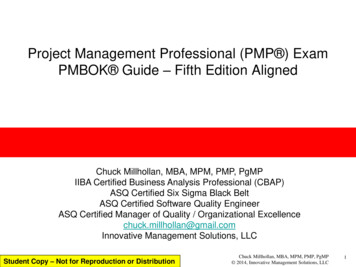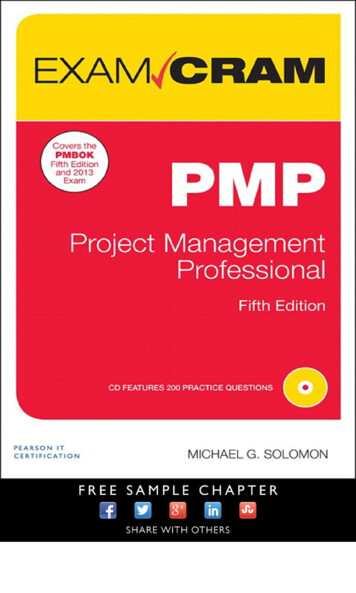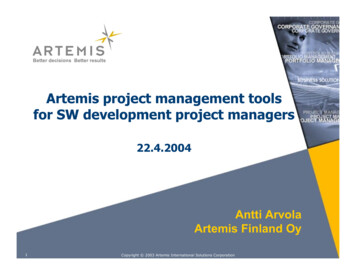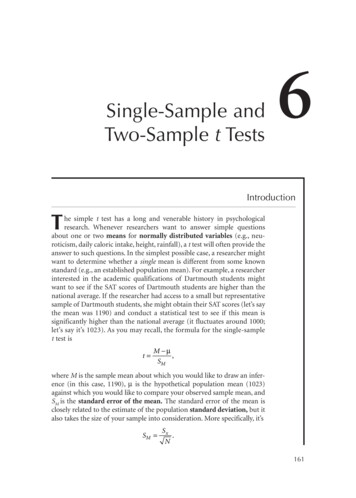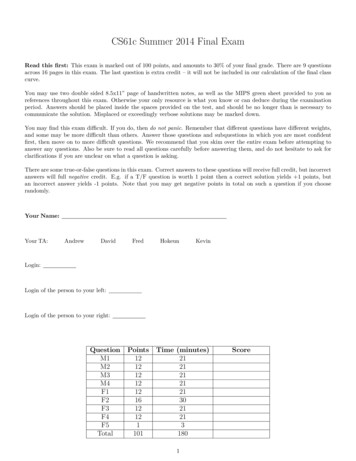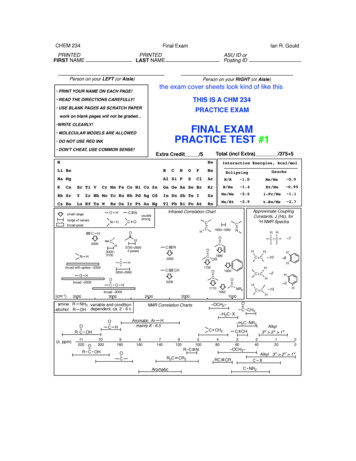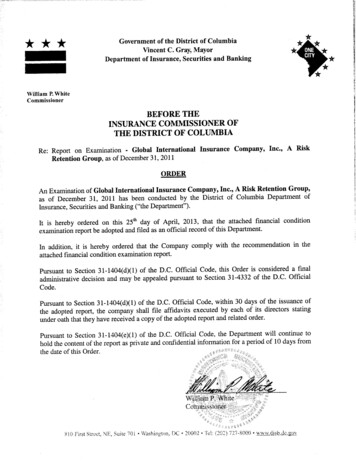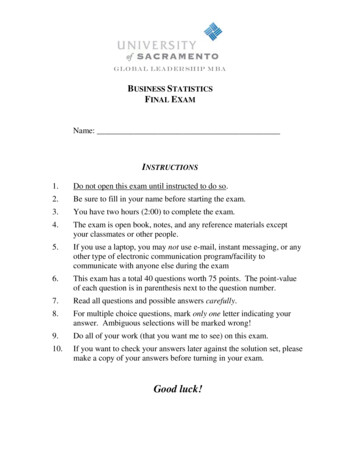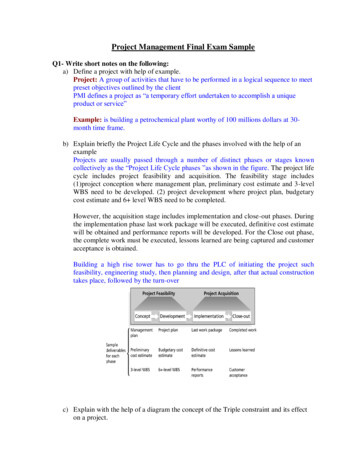
Transcription
Project Management Final Exam SampleQ1- Write short notes on the following:a) Define a project with help of example.Project: A group of activities that have to be performed in a logical sequence to meetpreset objectives outlined by the clientPMI defines a project as “a temporary effort undertaken to accomplish a uniqueproduct or service”Example: is building a petrochemical plant worthy of 100 millions dollars at 30month time frame.b) Explain briefly the Project Life Cycle and the phases involved with the help of anexampleProjects are usually passed through a number of distinct phases or stages knowncollectively as the “Project Life Cycle phases ”as shown in the figure. The project lifecycle includes project feasibility and acquisition. The feasibility stage includes(1)project conception where management plan, preliminary cost estimate and 3-levelWBS need to be developed. (2) project development where project plan, budgetarycost estimate and 6 level WBS need to be completed.However, the acquisition stage includes implementation and close-out phases. Duringthe implementation phase last work package will be executed, definitive cost estimatewill be obtained and performance reports will be developed. For the Close out phase,the complete work must be executed, lessons learned are being captured and customeracceptance is obtained.Building a high rise tower has to go thru the PLC of initiating the project suchfeasibility, engineering study, then planning and design, after that actual constructiontakes place, followed by the turn-overc) Explain with the help of a diagram the concept of the Triple constraint and its effecton a project.
TimeCostScopeThe Triple constraint, scope-cost-time, is a key aspect of project management becauseeach facet is critical and related to the other two. In fact changing one almostinevitably changes one or both of the others. If a decision is made to speed-up theschedule and complete project earlier than planned, this may require either reductionof project scope or assigning more resources. Assigning more resources will jack-upthe cost very high. If the emphasis is on time, the completion date will be the dominant factor. Forexample, the refurbishment of a hotel would be time influenced if it had to meetthe holiday season. When cost is the main consideration, contracts are awarded to the lowest bidder.If the contractor trades cost in preference to schedule, this preference could belater reversed when time penalties rear their ugly head. In high technology projects quality requirements often have priority over time andcost. The quality requirement is usually defined in the contract and therefore notnegotiable without a scope change.d) Explain briefly the project manager’s role and responsibilities. (will be modified)The Project Manager: beside managing the project effectively, he/she is expected toperform related roles by leading, negotiating, communicating, running interface,prioritizing, and so on. The professional responsibilities are:Professional conduct, integrity, responsibility for action of the team, selfimprovement, fairness, honesty, communication.e) Describe briefly how and why the projects originate.Some factors that might necessities project origination such as: Obsolescence (we have software that need updating) Competitive forces (our competitors building a new superstore) Client requirement (we bid on RFP and won) Employees suggestion (an employee has an idea to produce better widgets) Other sources (company owner has vision of robot that can scramble eggs)
Q2-What are the four quantitative factors that are used for project selection, whichtend to focus on cost and explain each one of them with the help of an example.The four quantitative factors are:a) Benefit-Cost Ratio (BCR)b) Present Value (PV)c) Net Present Value (NPV)d) Payback Period (PP)a) BCR compares benefits to costs and determining BCR Benefits/Cost. The higher theratio, then the better the deal is. For example: you have 2 alternatives ways to performa group of work packages worth of 200,000 in progress payments from the client.Using company A will cost 50,000, but Company B is willing to do the same workfor 40,000. In case company A, the BCR is 4:1 where as company B BCR is 5:1.Thus company B is the better deal since it has higher BCR.b) Present Value: it is a simple process of calculating the value today of future cashflows. PV (future value)/(1 i)n the present value is future value discounted tospecial interest rate per the time measure.Example: if you have a deal with contractor to give you 3,000 today or 3,800 after3 years. If the interest rate is 10%Then the present value of 3,800 3800/(1 0.10) 3 2855Thus, the value of 3,000 today is much better than having 3,800 after three yearsbecause the value of 3,800 will be only equal to 2,855 today.c) NPV: net present value is the real value of cash flow in a project is dependent on thedollar amounts and the timing for both revenue and cost. NPV logic looks at both theinflow and outflow of money over time.NPV PV revenue – PV costs (both over the flow of time)If you are buying software, then you might make a decision whether to buy fromcompany A or B.Company A asks for 8,000 at year o and 1,000 for year 1, 2 & 3.Company B asks for 0 at year 0 and 4,000 at year 1,2 & 3 as mentioned in thebelow table. Which company would you choose if interest rate is 10% per year.Year0123TotalCompany pany B04,0004,0004,00012,00003,6363,3063,0059,947From NPV calculation, company B looks more attractive where NPV 9,947 whereascompany A NPV 10,486
d) Payback Period is approach that calculates how long it will take to earn or savemoney as much as you have invested. Example, if you invest 4,000 in a newequipment, then receive zero benefits at year 1 &2 and then 1,000 per yearthereafter. The payback will occur at year 6.Q3- Explain in detail the needs assessment (functional and technical) and formulatingGood objectives using an example.Needs assessment requires that needs exist on a variety of levels among the variousproject stakeholders. This is simply because everyone has different needs. For example,suppose a contractor has been awarded a contract to build a new bridge. The customer,owner, commuter, environmentalists, local politicians, and others all have needsassociated with this project. Functional requirement are what the customer needs tohave happen. Technical requirement are what the project team develops to meet thetechnical requirements.Formulating good objectives: Objectives must be considered as an outgrowth ofcarefully considered needs. They should represent an understanding between those whoneed something and those who can provide it. Well developed objectives arecharacterized by the five elements of the SMART model.Q4- Describe Project Charter and Project Requirement Documents and its relevance toProject Management. Construct a sample Project Charter and ProjectRequirement documents to explain your description.Project charter is a written agreement among senior management, the project managerand functional managers. It is essentially a contract that gives the project manager theauthority for the job that he or she is being asked to do.Project Requirement Document: it is a document that outlines for the project managerwhat need to be accomplished. PRD contains information about the project background,objectives, deliverables, milestones, assumption, and so on. It is a written record ofwhat has already been discussed and decided upon and serves as the roadmap to directthe project team.Example: (use the one in the home work)Q5- Elaborate the statement “deliverable-oriented grouping of project elements thatorganizes and defines the total work scope of the project. Each descending levelrepresents an increasingly detailed definition of the project work”. Also list thevarious benefits and demonstrate your understanding by building a model.PMI defines the WBS as deliverable-oriented of project elements that organizes anddefines the total work scope of project. It does not mean that the WBS is defined onlyto the deliverable level. It means resources; budget or schedule can not be estimatedwith any accuracy unless the WBS is taken to the tasks or work package level. WBS isessentially the scope statement reduced to individual pieces of work.Benefits and uses of WBS:1) Identifies all work necessary to accomplish project’s objectives.2) Identifies specific work packages for estimating and assigning work3) Provides structure for measuring success4) Clarifies responsibilities
5)Forces detailed planning and documentation.WBS Model: there are two common forms of WBS;1) Indented format offers several advantages. Easier to include project details, easier toload to major software and easy to edit.Example; summer vacationSummer VacationDestination PlansTheme Park dayWater Park dayFamily VisitBaseball gameTravel PlansObtain motor club road mapReserve en route hotelPlan for kid’s in-car activitiesFinancesBasic costSpending moneyKid’s fun money2) Graphic format is good for showing the relatives level of the work and how samllercomponents of the project roll up into larger onesSummer VacationDestination PlanTravel PlansFinanceTheme parkRoad mapsBasic costWater dayReserve hotelSpending moneyBaseball gameKids activity in carKids fun moneyFamily visit
Q6- Explain in detail the Critical Path with the help of an example and demonstrateways of speeding up the schedule whilst defining the term “Crashing”.Critical Path is the longest uninterrupted chain of activities through a project. Ittherefore determines the duration of the project and shows tasks that must happen ontime in order to complete the project without any delays. Example; if you have aproject with chain activities having zero float time, then the project will flow throughactivities A, B, C, D & E. this is what it is called critical path. Project manager needs tounderstand the project’s critical path, so he can improve decisions about resourceallocations.There are 2 ways to speed-up schedule. 1) Crashing, 2) Fast trackingCrashing: taking action to decrease the total project duration after analyzing alternativesfor the least cost without reducing project scope by adding resources.Fast Tracking: Compression of the project schedule by overlapping activities thatwould normally be done in sequence, such as design and construction. Thedraw back of FT is the increased risk incurred through overlapping
Q7- Good cost planning requires a basic understanding of how organizations accountfor cost”. Explain the characterization of cost components and the two approachesto estimating project costs.The two fundamental cost components are:Direct cost; are cost attributed to the project such labor, materials, and equipment.Indirect cost; are costs for organizational support not directly attributed to the project,such as overhead, office electricity and heating.The two approaches to the top estimating project costs areTop-down estimating: it is used for early cost approximations using broad categories ofwork. Example; estimate of building hotel based on historic data regarding costs persquare foot. These estimates suffer from variances of 25 to 50 %.Bottom-up estimating; it can be accomplished only after completion of WBS to thework package level. The process is to fully develop the WBS, calculate cost estimatesat the work package and finish by totaling all estimates to arrive to the cost estimate forthe entire project. The cost estimate within 5 to 10% variance.Q8-Describe briefly how you transform a WBS into a Network Diagram and draw anetwork diagram for the following set of activitiesActivityABCDEFGPredecessorsStart None ProjectAAAC and DB and EFDuration in working days5155101555To create a network diagram for a project, you start with the work package level of the WBS.The work packages will become the network activities. The higher levels of the WBS are notschedule because they comprise the work packages and the work packages were determinedto be the WBS level at which work could be assigned and monitored most effectively. Twocharacteristics must be identified for each network activity. One is the duration of theactivity; the other is the activity’s logical relationship to other activities in the schedule.Determining logical relationship means identifying predecessor activities and successoractivities
B15 daysACEFG5 days5 days15 days5 days5 daysD15 daysQ9-Explain the following with examples:b. Resource/responsibility matrixc. Resource loading histogramsd. Resource leveling techniquese. Resource leveling techniquesa) A responsibility matrix is a way of showing resource (person) is responsible for eachtask or group of tasks. It is simply a grid with people identified along on axis andtasks along the other. Each person’s role in relation to a particular task may then behighlighted as in the following example:PhaseDevelop req’mtDevelop planSelect vendorInstall systemTest systemProject mngrPPAAAProject teamPPPRPSoftware vendorPayrollPRAPATimesheet Automation Project (P perform, R review, A approveb) Resource loading histogram is based on WBS. It requires assignment of resources toeach work package. Normally the resources assigned are personnel, but his tool canalso be used for planning equipment. The end result is a vertical bar chart that showsresources allocation over the life of the project. Each vertical bar represents thequantity required for each time period based on some standard unit. The quantities arecalculated based on the resources requirement, together with start and finish dates thathave been developed for each work package.
c) Resource leveling is a technique that addresses the kinds of scheduling and resourceadjustment. For example; i) Limited Resource Availability and ii) difficult to managechanges in resource levels. i) in this case (LRA) the problem that you don’t haveenough people to do all activities on their schedule performance dates. ii) in this case,you are trying to avoid the inefficiencies and resulting cost increases with swins in thenumber of resources involved in the work. Resource leveling may be accomplishedwithout extending the project schedule in some cases by taking advantage of floattimeQ10- Explain earned value and variance with the help of an example and summarizeProject Evaluation.Earned value analysis is a tool that effectively pulls all the three sides of the tripleconstrain into a single monitoring formula. It does this by correlating three pieces ofdata- planned work, actual cost and value of the work done- to assess how the project isperforming.PV planned value is that portion of the approved cost estimate planned to be spent onthe activity during given period. Example; 1,000 task that evaluated at the 30%complete period would expect to have spent 300AC Actual Cost is the total costs incurred in accomplishing work on the activity duringthe given periodEV earned value is the value of work actually completed during a given period. It iscalculated by EV (% complete * total PV for the activity)Variances are simply the differences between what you have accomplished and whatyou had planned to accomplish. When you know the three basic EV elements, it is easyto determine variances in cost CV and schedule variance. The formula for calculatingthese two figures are:CV EV-AC and SV EV-PVIn both formula, positive values indicate good performance ( a cost saving or beingahead of schedule). Negative value indicates poor performanceProject evaluation is a periodic process that may be done every month, quarter, orwhenever it is most appropriate. It gives a chance to step back and figure out how yourproject is performing. In evaluating the project you should focus on the big pictureissues and trends.You may choose among various courses of action as the result of an evaluating If things are going well and no new risks are on the horizon, then stick to plan If they are not on the plan, then you may need minor or major adjustment. If you have failed project, you may decide to terminate the projectSunk cost: are what you have spent and you can not recover
Q11- What is Risk Planning? Describe Risk identification, Risk Probability& effect,and Risk Response strategy.Risk planning is the process of deciding how to approach and plan the risk managementactivities for a project. It is an integral part of planning for major projects.Risk identification; a risk is “uncertain event or condition that if occurs, has a positiveor negative effect on projects’ objectives. As you plan, you are not necessarily planningfor the very worst possible scenario, but you do not want to ignore some of the badthings that might happen such as delayed permits, bad weather, loss of key teammembers, and so on.Risk probability & effect; there are 2 key questions to analyze for each risk you identify What is the probability of the risk actually happening? What would be the impact of the risk on the project if it did happen?Based on an assessment of the probability and effect of each identified risk, the projectteam should prioritize the risks. Prioritization is an essential step because you are notlikely to have the resources to prepare for everything and because some potential eventsare too low in priority to be worth planning for.Risk Response Strategies; after you have identified the risks that worth planning for,then you can actually choose from at least four strategies:1. Avoidance: this strategy requires changing the project plan to eliminate the risk orcondition to protect the project objectives.2. Transference; transference means shifting the risk to a third party3. Mitigation; risk mitigation means reducing the probability of an adverse risk to anacceptable threshold.Acceptance; some time accepting the risk to avoid changing the project plan is the mostsensible approach of all because any other response has cost that exceeds benefits.
Project Management Final Exam Sample Q1- Write short notes on the following: a) Define a project with help of example. Project: A group of activities that have to be performed in a logical sequence to meet preset objectives outlined by the client
